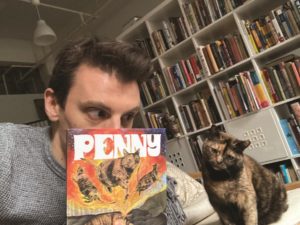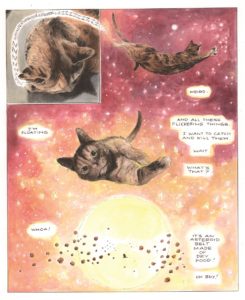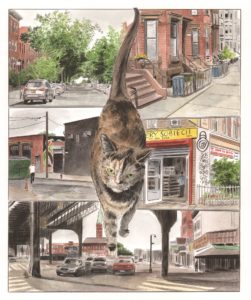Most anyone who spends time with a cat will ask what goes on behind the impenetrable stare of its almond-shaped eyes. The Boston-based comic artist and painter Karl Stevens posits an answer in Penny: A Graphic Memoir, a delightful mix of punchy humor and existential angst that was published on May 4 by Chronicle Books.

Penny, the book’s protagonist, was inspired by Stevens’s own cat. A stray turned pet, she tells her story as she goes about the daily business of a house cat, including fantastic escapes into the outside world. Stevens straddles the line between anthropomorphism and observable cat behavior in Penny’s perfectly pitched stream-of-consciousness narration.
The author of four graphic novels and a cartoonist at the New Yorker and other publications, Stevens is having a show of the original ink and watercolor artwork from Penny at the art and design store Room 68 in Provincetown through mid-June. (Individually framed pages and the graphic novel are for sale.)
“Karl is one of the most dedicated and talented artists that I know,” says Brent Refsland, owner of Room 68. “I want to highlight his process — each crosshatch, his control of watercolor — celebrating the overall success and detail on each page.”
Penny’s ruminations alternate between everyday events of her feline existence and deeper questions about the human condition. “I need three things in life,” she announces on one page. “Food in my dish, a clean toilet box, and some people servants to take care of those things.” On another page, she muses, “What is it that we are looking for? Is it love? Affection? Acceptance?”
Some of the most bizarrely captivating passages in the book happen when Penny, frustrated with the mundane repetitiveness of her life, drops off into vivid dreams or disappears through a secret portal into an unknown dimension. During one of these journeys, she declares, “I am one with the cosmos. I can sense the eternal vibrations with every fiber. I can see through our own plane and witness alternate lives in other realms.” Her metaphysical meanderings are interrupted by a train of floating Friskies: “What’s that? It’s an asteroid belt made of dry food!”

“Cats seem distracted, as if they’re in their own otherworld, participating in something we’re not,” Stevens says. The idea to do a comic based on Penny’s life was spurred by the late Tom Spurgeon, author of the popular Comics Reporter blog, who brought Stevens to the attention of the Village Voice in 2016.
“I met with them and they were pitching ideas, but nothing was landing,” he says. “Then my wife said, ‘Why don’t you do something about Penny?’ Well, everyone loves cats.” The strip has run there ever since. He dedicated the Penny book to Spurgeon.
“Penny is the perfect model, even though she’s complicated to draw,” Stevens says. “I’d watch her, come up with something she might be thinking and see where it went.” When sketching, he worked from reference photos of Penny to find the right expressions and poses.
Sometimes, however, “it was funnier if what she was thinking was different from the expression on her face,” Stevens says. “It’s mirror-life, in that sense, because what comes out of our mouth can be a lot different from how others perceive us.”
Stevens’s style of drawing is more intricate and realistic than what is commonly found in comic art. By studying such masters as Dürer and Rembrandt, he developed what he calls a “fine art line,” as opposed to the crisp, abstract approach used by most comic artists. “Realism has been out of favor in art for most of the 20th century, but it seems more relevant today given the contemporary horrors we face,” Stevens says. “Now is not the time for abstraction.”

Born and raised in Western Mass., Stevens began copying comics such as Peanuts and Calvin and Hobbes when he was just four years old. “That’s when I really fell in love with the form,” he says.
In middle school, Stevens began to self-publish mini-comics with his friends. “We each drew and wrote stories, photocopied them at the library, and sold them at school. It was really serious,” he says, and chuckles to himself.
By the time he got to high school, Stevens knew he wanted to become a professional cartoonist. “From that point, I was neglecting all the other classes. I was reading and studying comics, and I developed a love of literature as well. I was precocious as a teenager. I read trade journals. Back then, in the ’90s, they were calling for comics to be treated as an art form. I was absorbing all that and thinking, comics can be art and literature.”
Stevens, who has worked in Boston museums for years to help pay the bills, feels that the perception of comic art is currently changing in exciting ways. “Comic book pages being shown in a gallery as individual artworks — it’s the trend of the art world nowadays. Comic art is being sold at auction houses for seven figures. The boomer idea that comics aren’t art is evaporating with them.”
A Penny for Your Thoughts
The event: A show of original artwork from Penny: A Graphic Memoir, by Karl Stevens
The time: 11 a.m. to 6 p.m. daily, through June 15
The place: Room 68, 377 Commercial St., Provincetown
The cost: Free; Penny artwork and books are for sale



